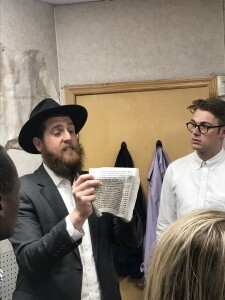BYU communications students gained a wider worldview through exposure to religious and cultural diversity during the Spring 2019 New York Experience
This past spring, 23 communications students traveled to New York City with hopes of immersing themselves in everything the Big Apple has to offer. Students were enrolled in two courses — Media and World Religions as well as Gender, Race and Class in the Media — while living in the heart of Manhattan. The experience went deeper than their coursework, however, as students came back asking, “what kind of person do I want to become?”

New York Experience students are part of the pre-show hype before Good Morning America goes on the air. Left to right:(front) Cecilee Henstrom, Egypt Byrd, Savannah Hogan, Kezia Dearden, (back) Karani Namunyu, Emily Walker, and Emma Benson. (Courtesy of Joel Campbell)
Although the students visited places like the Statue of Liberty, Yankees Stadium, and Good Morning America, deeper learning came from first-hand experiences where they discovered the diversity of the city.
In one instance, students spent five hours in Brooklyn Heights with the Chabad Lubavitch Orthodox Jewish Community where they learned about Jewish lifestyle — including their traditional fashion and meal choices.
Joel Campbell — a professor in the School of Communications and the faculty mentor on the trip — described a special experience inside the home of Rabbi Yoni Katz, an Orthodox Jew. Students encountered a traditional Kosher kitchen where one kitchen is used for cooking meat — specifically animals that have been properly slaughtered and prepared according to the Jewish dietary laws — and another for cooking and preparing dairy products. Both kitchens also require entirely separate utensils and cookware. As students munched on customary Kosher food, Katz’s wife expressed her deep reverence of the Sabbath day to the group.

Chabad Lubavitch Orthodox Jewish Rabbi Yoni Katz explains the role of the shofar, or scribe, for Torah scrolls while Tyler Richardson looks on. (Courtesy of Joel Campbell)
“The cross-cultural and inter-religious spiritual feelings were moving,” Campbell recalled.
Communications studies major Savannah Hogan expressed the importance of the discussion in expanding her worldview.
“I went in kind of blind. You hear lots of stereotypes, but it was different to hear it from his actual perspective,” Hogan stated. “I found it so cool how devoted they were. Their whole lives are their religion. It inspired me to be more that way even as a member of The Church of Jesus Christ of Latter-day Saints. Maybe I don’t have to have two fridges, and two sinks, and two microwaves but I can do something to make my faith more relevant in all areas of my life.”
Students’ exploration of religious freedom in America continued in Flushing, Queens where they learned about the declaration of religious freedom granted by the Quakers during America’s origins. Students also assisted the BYU Law School in its joint Religious Freedom Conference held at Congregation Shearith Israel Synagogue, one of the oldest congregations in the United States.
“I learned about things that I don’t have as much opportunity to experience on campus or in Utah in general,” Hogan said. “I realized that there are many religions that are similar to mine. I think we have a lot more in common with other faiths and cultures then we realize.”
At the Tenement Museum on the Lower East Side, experiential learning came as students packed into the small rooms to learn about the lives of 19th century immigrants in the United States. Additionally, students spent time in Harlem learning about African American culture and history.
Through the exposure of a variety of religions, races and cultures, students were able to find common ground with those who believe or live differently than they do.
“Since I grew up in Utah, I was never really around religious or racial diversity,” Hogan said. “I realized that it is important for everyone to feel like they’re being heard, that they’re being respected and that their rights are protected.”